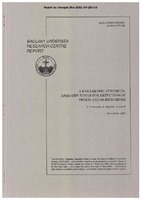| dc.contributor.author | Fioravanti, Stefano | |
| dc.contributor.author | Maguer, Alain | |
| dc.contributor.author | Lovik, A. | |
| dc.date.accessioned | 2018-10-11T14:08:37Z | |
| dc.date.available | 2018-10-11T14:08:37Z | |
| dc.date.issued | 1997/12 | |
| dc.identifier | 11902 | |
| dc.identifier.govdoc | SR-268 | |
| dc.identifier.uri | http://hdl.handle.net/20.500.12489/491 | |
| dc.description.abstract | This paper describes an experimental comparison between a parametric sonar and a conventional sonar for the detection of small objects on and in, the sea bed. Two experiments were performed in France (GESMA site) in October 95 and March 96 in order to assess the feasibility of detecting buried mines using a parametric sonar configured as a sidescan sonar working at very low grazing angles (well below the critical angle) where the Snell theory restricts any bottom type 2 penetration of the sound into the sediment. There is however substantial evidence of penetration below the critical grazing angle which may be explained by different theories (such as for example bottom roughness, evanescent waves, Biot waves, Narrow beam-width). In the two experiments the parametric array was mounted on a platform which was able to move linearly at a constant speed (0.25 m/s) on a rail. Objects were positioned on and in the sea bed at ranges from 17 m to 60 m. The buried targets were detected at grazing angles of the order of 16°, well below the critical angle of 28°. The comparison of the Peak Signal to Bottom Reverberation Ratio (PSSR) obtained with high and low-frequency is performed for the proud and buried targets. It is shown that the PSSR is of the order of 5 dB higher for the low frequency than for the high frequency due mainly to the higher level of bottom reverberation at high frequency. It is shown that detection of buried targets was only possible with low frequencies, | |
| dc.description.abstract | emphasizing that sub-critical penetration into the sediment is possible. No detection was observed with the high frequency due to the higher attenuation into the sediment at this frequency. While the | |
| dc.description.abstract | sonar was moving on the rail it was possible to perform synthetic aperture sonar processing with the | |
| dc.description.abstract | parametric array. Significant improvements in resolution and signal-to-noise ratio were also obtained by integrating successive pings transmitted while the sonar was in motion. The proud targets were | |
| dc.description.abstract | precisely located within the mine field and gains of 10 dB and 5 dB respectively were obtained for the | |
| dc.description.abstract | proud and buried targets. | |
| dc.format | 39 p. : ill. ; 26 fig. | |
| dc.language | English | |
| dc.publisher | NATO. SACLANTCEN | |
| dc.relation.ispartofseries | ADB235495 | |
| dc.subject | Mine burial and bottom conditions | |
| dc.subject | Synthetic Aperture Sonar (SAS) | |
| dc.title | A parametric synthetic aperure sonar for detection of proud and buried mines | |
| dc.type | Scientific Report (SR) | |
